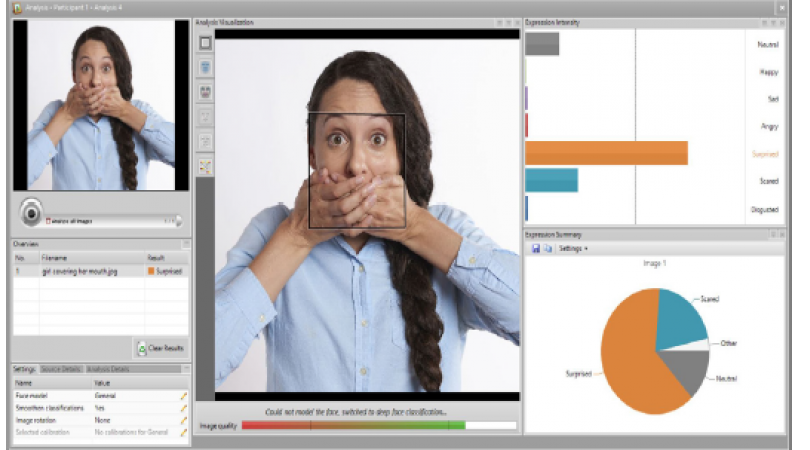838 阅读 2020-09-01 09:55:02 上传
以下文章来源于 十分语言学
具身语言学的研究方法系列之计算研究方法-虚拟现实(Virtual Reality)

基本概念:
沉浸式虚拟现实(iVR)是一种快速发展的技术,可以将被试置身于虚拟世界中。通过立体视频投影,以及模拟三维音景的音频系统,使虚拟物体看起来是可触的触觉刺激器,有时甚至用到嗅觉刺激器。传统的语言或图像刺激可以引导被试想象; iVR可以实现在感官上的体验,因此,iVR提供了一定程度的丰富性和真实感,这在传统的实验室实验中是不可能的,同时使研究人员能够对刺激和实验环境保持严格的控制。当前最流行的具身语言就是采用这个沉浸式的虚拟现实(Legault, Zhao, Chi, Chen, Klippel, & Li, 2018),也是未来人工智能实验语言科学实验室必备的技术和仪器。
研究假设和理论基础:
语言最初是通过虚拟现实(VR)手段发生的。在现实世界中,我们所能体验的东西受到周围环境、距离以及感官的限制。通过语言,我们可以超越这些限制,创造出无数可能的“虚拟”现实,不同人对于同一个现象的理解也会不同,这就是具身视角切换的问题(Mac Whinney & Guan,in press)。
iVR提供了在实验室中难以实现的丰富度和真实感,同时也可实现对刺激和实验环境严格的实验控制。实验者可以同时激发多种感官,并行收集多组数据(例如,声音反应,身体运动;配备有眼球跟踪器和脑电图仪(EEG)的iVR实验室可获取眼球运动和电生理数据。)通过让被试浸入虚拟世界,与传统方法相比,iVR可能会引发对情绪或社会刺激更自然的反应。

研究工具:
iVR的硬件可分为两种类型。输入硬件“捕捉”来自现实世界的数据,例如被试位置和运动。输出硬件通过向被试呈现视觉,听觉和触觉信息的某种组合来“表征”世界。在中间,连接设备是一台计算机用于处理输入并使用它来产生输出。
实验设计和数据分析:
在VR实验中,虚拟世界本身就是一种刺激,有无数的参数变化。需要根据实验的科学问题选择要控制的参数,包括人和周围环境。各种输入设备在数据收集方面具有很大的灵活性,有无数的选择来呈现和操纵刺激。如果实验需要口头反应,可用麦克风收集,并保存为WAV音频文件(https://en.wikipedia.org/wiki/WAV),用于语言或声学分析。任何动作捕捉设备都可以提供实验中每个时间点,每个标记在空间中的精确坐标。然后,就可以将这些动作与实验中的事件或其他行为(如发声)锁时关联(time-lock),并绘制图示,分析运动。被试声音的音频可用Pratt分析,(Boersma & Weenink, 2011)。同时,可用Matlab (Mathworks, Natick, MA) 计算速度和加速度。
评价:
在优点方面,除上述的丰富性和感官运动现实性,以及变量易于控制以外,iVR在以下这些方面也具有优势,扩大了可做为被试的人群的可能性 (Blascovich et al., 2002; Fox et al., 2009),创造了真实情感;再现复杂的环境,是具身语言研究的最前沿趋势之一。但iVR的真实性也有不利的一面,高度和运动的假象可能会引起少数被试的不适,而且虚拟现实中的学习效果是否优于传统的学习方式,它的认知神经机制是否会受到调节,都是尚待解决的科学问题;其次,即使一个简单的iVR研究,也需要大量的时间和金钱的投资和打理,尤其是VR影像素材的设计,是花费很大精力的。
参考文献:
[2] Boersma, P. (2001). Praat, a system for doing phonetics by computer. Glot International, 5, 341-345.
[3] Boersma, P., & Weenink, D. (2011). Praat: Doing phonetics by computer [computer program]. Version 5.2.46. Retrieved 10 September 2011 from http://www.praat.org
[4] Legault, J., Zhao, J., Chi, Y., Chen, W, Klippel A., & Li, P. (2018). Virtual Reality as an Effective Tool to Train Second Language Vocabulary. Poster Presented at 6th International Workshop on Advanced Learning Sciences, Pittsburgh, U.S. A.
Virtual Reality
Abstract: Immersive virtual reality (iVR) is a fast-developing technology, which can place the subjects in a virtual world. Through stereo video projection and audio system simulating 3D sound scene, the virtual objects seem to be tactile stimulators and sometimes the system even has an olfactory stimulator. Traditional language or image stimulation can guide subjects' imagination; iVR enables sensory experience and as a result iVR provides a certain degree of richness and realism, which is impossible in traditional laboratory experiments. It also enables researchers to maintain strict control over stimulation and experimental environment. At present, the most popular embodied language uses this immersive virtual reality (LeGault, Zhao, Chi, Chen, Klippel, & Li, 2018), which is also the necessary technology and instrument for the future AI experimental language science laboratory. In the real world, what we can experience is limited by surroundings, distance, and senses. Through language, we can transcend limitations and create countless possible "virtual" realities. Different people have different understandings of the same phenomenon, which is the problem of switching the embodied perspective. In the VR experiment, virtual world itself is a kind of stimulation with numerous parameter changes. It is necessary to select the parameters to be controlled according to the scientific problems of the experiment, including people and the surrounding environment. iVR has advantages in the following two aspects. Firstly, it can extend the possibility of people being subjects; Secondly, it creates real emotions. However, the illusion of height and movement may cause discomfort to a few subjects and a simple iVR research needs a lot of time and money investment and management.













